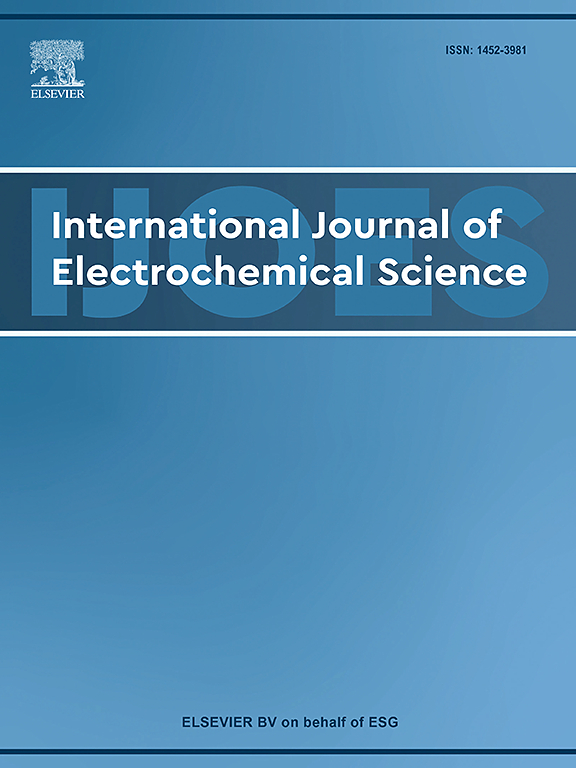Prediction of fast-charging capabilities in LiFePO₄/graphite lithium-ion batteries using internal resistance and machine learning
IF 2.4
4区 化学
Q4 ELECTROCHEMISTRY
International Journal of Electrochemical Science
Pub Date : 2025-09-13
DOI:10.1016/j.ijoes.2025.101181
引用次数: 0
Abstract
The fast-charging capability of lithium-ion batteries is a crucial performance indicator, yet its accurate evaluation remains a significant challenge. The maximum chargeable state of charge (SOC) at a specific fast-charging rate is closely correlated with fast-charging capability; however, it is difficult to measure via non-destructive testing. In this study, we investigate the potential correlation between a highly measurable battery parameter (i.e., internal resistance) and this hard-to-measure parameter (i.e., maximum chargeable SOC) using machine learning. Given the difficulty in generating large datasets containing internal resistance and maximum chargeable SOC through experimental methods, a virtual dataset is created via the P2D electrochemical model using PyBaMM—an open-source Python-based P2D simulation tool. Using PyBaMM, we simulate 100 virtual LiFePO₄/Graphite lithium-ion batteries with distinct electrochemical kinetics, from which internal resistance data (at various SOC levels and times) and maximum chargeable SOC (at a 3 C charging rate) were extracted to form the dataset. Using this dataset, we employ machine learning to predict maximum chargeable SOC from internal resistance. Results show that the average prediction error between the machine learning-predicted maximum chargeable SOC and the dataset's P2D-simulated benchmarks is below 0.05, with a maximum error of 0.11. Furthermore, compared with experimental measurements, the machine learning-predicted maximum chargeable SOC is highly consistent with values measured via three-electrode experiments. This study demonstrates that a well-designed linear model, with carefully engineered features derived from domain knowledge, can achieve highly satisfactory performance while offering significant advantages in interpretability, reliability, and computational efficiency—attributes critical for real-world industrial applications in battery design. It thereby establishes the potential of using the highly measurable internal resistance of batteries to predict the hard-to-measure fast-charging capabilities in LiFePO₄/Graphite lithium-ion batteries, enabling faster and more efficient evaluation in the design process of fast-charging batteries.
利用内阻和机器学习预测LiFePO₄/石墨锂离子电池的快速充电能力
锂离子电池的快速充电能力是一项至关重要的性能指标,但其准确评估仍然是一个重大挑战。特定快速充电速率下的最大可充电状态(SOC)与快速充电能力密切相关;然而,很难通过无损检测来测量。在本研究中,我们使用机器学习研究了高度可测量的电池参数(即内阻)与难以测量的参数(即最大可充电SOC)之间的潜在相关性。考虑到通过实验方法难以生成包含内阻和最大可充电SOC的大型数据集,使用pybam(基于python的开源P2D仿真工具)通过P2D电化学模型创建虚拟数据集。利用PyBaMM模拟了100个具有不同电化学动力学的虚拟LiFePO₄/石墨锂离子电池,提取了内阻数据(不同SOC水平和时间)和最大可充电SOC(3 C充电速率),形成数据集。使用此数据集,我们使用机器学习从内阻预测最大可充电SOC。结果表明,机器学习预测的最大可充电SOC与数据集p2d模拟基准的平均预测误差小于0.05,最大误差为0.11。此外,与实验测量结果相比,机器学习预测的最大可充电SOC与通过三电极实验测量的值高度一致。这项研究表明,一个设计良好的线性模型,加上来自领域知识的精心设计的特征,可以实现非常令人满意的性能,同时在可解释性、可靠性和计算效率方面提供显著优势——这些属性对于电池设计中的实际工业应用至关重要。因此,它建立了利用电池高度可测量的内阻来预测LiFePO₄/石墨锂离子电池难以测量的快速充电能力的潜力,从而在快速充电电池的设计过程中实现更快,更有效的评估。
本文章由计算机程序翻译,如有差异,请以英文原文为准。
求助全文
约1分钟内获得全文
求助全文
来源期刊
CiteScore
3.00
自引率
20.00%
发文量
714
审稿时长
2.6 months
期刊介绍:
International Journal of Electrochemical Science is a peer-reviewed, open access journal that publishes original research articles, short communications as well as review articles in all areas of electrochemistry: Scope - Theoretical and Computational Electrochemistry - Processes on Electrodes - Electroanalytical Chemistry and Sensor Science - Corrosion - Electrochemical Energy Conversion and Storage - Electrochemical Engineering - Coatings - Electrochemical Synthesis - Bioelectrochemistry - Molecular Electrochemistry

 求助内容:
求助内容: 应助结果提醒方式:
应助结果提醒方式:


